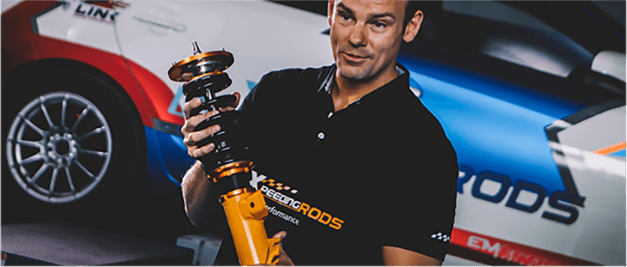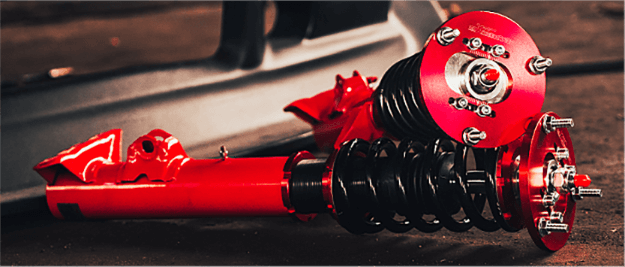Buying a coilover(Shocks or Struts) for your car can sometimes be a daunting and confusing task. At maxpeedingrods.com, it is our mission to make that task as an easy and painless as possible. This Buyer's Guide is designed to answer any questions you may have during your search for the right coilover for your car, and how to buy a coilover on our website.
What is a coilover?
The suspension system in your car improves its control and handling, giving you a smooth ride. It
achieves that by reducing the friction between the car tires and the road. The suspension system also
provides comfort on uneven terrain.
You can improve your car's suspension system using aftermarket upgrades such as airbag kits, adjustable
shocks, struts, and lowering spring kits. However, if you really want to improve your car's handling,
especially high-speed handling, you should consider coilovers.
The name coilover is a short version of ‘coil spring over shock'. Typically, what you get is a coil
spring that covers a shock or a strut.
So, how is it different? Most of the other suspension systems have the spring separate from the shock.
In fact, most car owners buy the two components separately. However, a coilover comes with preassembled
shocks and springs that are designed to perfectly fit each other and work in harmony. This will not only
make your car look better by reducing the wheel gap, but also greatly improve the car's handling and
performance.
The types of Coilovers are as follows:
Coilover sleeves resemble lowering spring. The main difference is that they are height adjustable. You can choose from a wide range of rates and lengths. They do not have a shock or strut. They are installed on your existing shocks, and they come with top mounts. These are entry level suspension upgrades – they have a low price and do not come with a Camber Kit.
• Non-shock Adjustable Coilovers
The key feature of the non-shock adjustable coilover is height adjustability. This is a full-bodied
coilover that comes with shocks. However, the shock is non-adjustable. That is to say; you cannot
adjust the rebound, compression, and stiffness of the shock.
Different manufacturers have different
designs. Most provide them pre-assembled with top mounts. These coilovers are a good option if you
want to lower your car and have the choice in the amount of lowering you want. With this type of
coilover, you have to purchase a Camber Kit separately.
These coilovers sport the same features of the non-shock adjustable coilovers. The difference
between the two is the shocks. In the shock adjustable coilover, the shock is adjustable and
perfectly dials into the suspensions.
The shocks allow smooth rebound and compression, and you can
adjust the stiffness. Shock adjustable coilovers are the most popular type of coilovers. They
provide a smooth ride in your daily driving. Racers like them as they can adjust the stiffness – a
feature that is crucial for track use. The price is mid-range, and they usually do not come with a
Camber Kit.
A shock adjustable coilover with a camber kit is one of the best suspensions upgrade you can get for your car. These coilovers come with height adjustment and adjustable shocks. Normally, they feature a front camber kit, with some advanced versions sporting the rear camber kit.
How does a coilover work?
The typical suspension system features a controlling arm, coil spring and a shock absorber or a strut.
The difference between a strut and a normal shock is that a strut carries some of the weight of the car.
Most of the time, the spring is mounted on the strut. In case of any compression on the strut, or the
spring, or both, the wheel moves upwards towards the body of the car.
The mechanism of the coilover is similar. It has a longer coil spring that is coiled around the strut.
For the upward movement of the wheel, both the shock and the spring must compress. The spring carries
the weight upon compression while the strut transfers or damps the bouncing to the spring.
How to choose the right coilovers?
If you're looking to replace a worn suspension, improve your car's handling, or just slam it to the
ground, coilovers are a must-have. There are several different brands, styles, and types out there, and
we are asked daily which kit is the best route to go for.
Which setup you choose is really more about what you plan to do with the car. The most expensive kit is
not always going to be the best option. There are a few things to keep in mind while shopping.
Most coilovers on the market will use a pillow-ball upper mount. This means a spherical bearing is
used as the joint between the strut assembly and the top-hat, where it mounts to the car. A
pill0w-ball will produce sharper, more precise handling, but it will also transmit vibration and
harshness through the suspension more easily, producing a harsher ride on the street.
Many newer brands are offering rubber upper mounts. These provide a slight amount of deflection,
compared to pillow-ball. While virtually of them will be stiffer than a stock setup, a coilover
using rubber mounts will be much more streetable than one using pillow-ball mounts. Here are some
popular coilovers and which mounts they use:
BC Racing BR Coilovers – Optional Rubber or Pillow-ball Mounts.
Powertrix Sport Street (SS) – Rubber Mounts.
Powertrix Road/Track (RT) – Pillow-Ball Mounts.
Additionally, some coilovers forgot the inclusion of upper-mounts altogether, and instead you just
re-use the upper mounts your stock suspension uses. Because the stock suspension uses a large,
rubber spring seat, this will almost always offer the smoothest ride, but is not always the best
choice for performance.
Coilovers are generally all adjusted the same way. You loosen the lock collars at either end, and
twist the main threaded shock body (sometimes called the “cartridge”). Twisting the shock body
effectively screws it into the lower mount (called the “cup”). Screwing it further into the cup will
lower the car, and unscrewing it will raise the car. If you're looking to go extremely low, you may
find that the car isn't as low as you like once you screw the shock body into the cup. The only way
to go lower from here is to unload the spring.
When you unload the spring, by spinning the spring's
lower mount around the threaded shock body, you create a condition called “droop”. This means the
spring is basically loose; you can physically jiggle it around. But when you set the car on the
ground, the shock compresses and sits on the spring like normal, and the result is that the car is
now lower.
Droop can be a dangerous condition, however. If you hit a large bump, the spring can
free-float between the upper and lower mounts while the coilover is unloaded, and there's nothing
forcing it to land correctly. So once the coilover compresses, the spring may land incorrectly,
causing serious damage.
Helper springs are thin, light springs that are installed between the main
spring and the spring mount. They are easily compressible, and exist purely to let the car go lower.
Keeping helper springs in place means that even if the main spring is unloaded during driving, the
helper spring will stretch out to maintain constant tension on it, keeping it in place to ensure it
will land correctly. This gives you the benefit of lowering the car more, but negates the dangerous
side-effects of you would otherwise get from the “droop”.
The spring sits in a cup on a control arm, and the shock mounts to spindle and body of the car. Many coilovers are available in both styles. Neither is truly superior to the other, though many feel a “true coilover” setup is a better choice for a car where performance is a higher priority. This is partially because switching to a true coilover setup allows you to replace the rear control arm which otherwise houses the bulky, heavy, spring seat.
Why buy coilovers at MaXpeedingRods?
MaXpeedingRods has been engaged in the research of overseas racing products and culture for
decades. If you are looking for coilovers, you have landed at the right place. On the basis of
your vehicle make and model, you can choose from a plethora of automotive maintenance and
accessories. MaXpeedingRods offers a seamless online shopping experience and the streamlined
e-commerce interface makes it easy for you to find just the coilover you want.
MaXpeedingRods offers a variety of coilovers in both Sport performance and Street performance.
• Forged L6061-t6 high quality aluminum alloy anodized gold coating
• Level 24 soft and hard damping adjustable
• Height (how many mm) adjustable
• With adjustable tilt tower top
• Imported anti-attenuation anti-high temperature special racing shock absorber oil
• Forged L6061-T6 high quality aluminum alloy
• High precision molding
• High viscosity antioxidant shock absorber oil
• Effectively reduce impact and prevent roll
• Good maneuverability and high stability

What are the signs that my vehicle needs new shocks or struts?
If you're wondering whether your vehicle needs to have the shocks or struts replaced, look for the following 6 signs:
1. Bumpy rideThe most obvious sign of a problem with your shocks or struts is that your car is giving you a much more uncomfortable ride than normal. You'll feel bumps more, so the ride will feel rough. If you feel like you're about to lose control of your car when you drive over a bump or pothole, it's likely your shocks or struts need to be checked out.
2. Steering problemsAnother telltale sign of a shock or strut problem is difficulty steering. Your steering wheel may feel stiff or hard to turn. And you may feel like your car is swaying or leaning when you take a turn or switch lanes.
3. Braking problemsBecause struts are a structural part of your vehicle, faulty struts can result in other problems beyond just suspension issues. You may notice that your car feels unstable, takes a nose dive or lurches forward when you brake.
4. Fluid leaksYou may notice visible wear and tear to struts if you know where to look. But the most common visual clue that your shocks or struts may need repair is a fluid leak.
5. Unusual tire tread wearWhen your suspension or wheel alignment is off, your tires will experience uneven tread wear, and it will usually look different than when your tires are just aging. Suspension damage can cause scalloped dips (“cups”) to develop around the edge of the tread. And this problem is very dangerous. If you notice any such signs on your tires, see a mechanic right away.
6. MileageCars need regular replacement of shocks or struts every 50,000 miles or so, depending on your car's make and model. Have your mechanic make a routine check of the shocks or struts every 50,000 miles, or however often your operating manual recommends it.

How to install a coilover in a car?
It is recommended that you get your coilovers installed at an auto shop. Still, a D-I-Y installation is not out of the question. Depending on the manufacturer and model, coilovers are shipped in different ways. You can either get them fully extended, collapsed, with the springs mounted, or with separate springs. The first thing you should do when you buy them is to inspect the contents of the package. You should determine that they are the right size for your car. Also, check that you have received sets for the rear wheels and the front wheels.
Step 1: Install the SpringInstalling the springs should be the first step if the coilover came with the springs separate. Most coliovers have an instruction manual detailing how to install the springs. Typically, you will have to first extend the shock. Then, slide the spring over the shock until it comes in contact with the spring retainer, also called the preload nut. If the coilover is dual rate, install the slider first before mounting the lower spring from the lower end of the shock. After installing the lower spring and the upper spring, there should be zero preload. So, you should make sure that both springs snug together. Also, at zero preload, there are no more than 3 inches of threads above the coil adjustment nut. Zero preload guarantees that there is no play between the coil nut adjusters, the springs, the slider, and the spring plate.
Step 2: Install the CoiloverTo install the fully assembled coilover, suspend the chassis using a jack and make sure the suspension is in full droop. Then, bolt the coilover using the right bolts (usually grade 8) with the lock washers and nuts. Lastly, lower the vehicle slowly. If you did everything correctly, after the vehicle weight rests on the coilovers, it will settle at your desired ride height. If it is slightly below the ride height, you simply need to add the amount of preload. You add preload by rotating the upper coil adjustment nut down. However, if it settled way below or way above the desired ride height, you need to change the springs because the problem could be that the spring rate.
Step 3: Test RunNow that you have installed the coilovers and set the correct preload, you can go for a test run. The test run will let you know if the coilovers need shock tuning or shock valving. Your main concerns on the test run should be the feel of the suspension. You want the coilover to achieve light handling, and also need the suspension to be strong enough to adequately support the weight of the vehicle.







